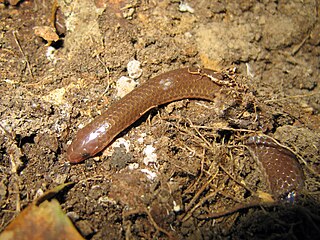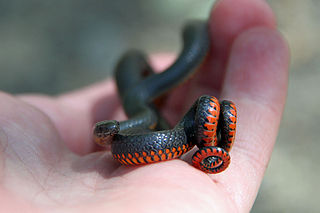Snakes that feed solely upon insects, earthworms, spiders, snails and other invertebrates are a great choice for folks who would rather not handle rats and mice. They also have other attractive characteristics, including small size, inoffensive natures, and adaptability to naturalistic terrariums containing live plants. What’s more, most receive scant attention as captives, and so offer us the opportunity to record new facts about their needs and habits. Several invertebrate-eaters, such as Brown Snakes (Storeria) and Ring-Necked Snakes (Diadophis), thrive in the hearts of large cities, while others, including the Worm Snakes (Carphophis), Black-Headed Snakes (Tantilla), Snail-Eating Snakes (Sibon), Red-Bellied Snakes (Storeria), Pine Woods Snakes (Rhadinae) and Flower Pot Snakes (Rhamphotyphlops), are sometimes collected and offered for sale. Today I’ll introduce this fascinating but over-looked group. Please see the articles linked below to read about others that can do without rodents, including Garter, Ribbon and Green Snakes.
Note: There are thousands of snake species that fit within this general category…please post your own experiences below, thanks, Frank
Description
Most invertebrate-eating snakes are shy and secretive, and measure less than 12 inches in length when fully grown (Garter and Ribbon Snakes, covered elsewhere, are an exception). Many, such as Brown and Worm Snakes, are well-camouflaged by their somber coloration, while Ring-Necked and Red-Bellied Snakes flash bright warning colors when disturbed.
Range
Invertebrate specialists occur from southern Canada to southern South America and in Europe, Asia, Africa and Australia – everywhere that “typical” snakes dwell.
Nearly all spend most of their time below leaf litter, decaying logs, rocks, or other cover that offers protection and access to grubs, earthworms, slugs and other prey. Some, such as the Eastern Worm Snake, have pointed heads that assist in burrowing, and rarely appear above-ground. However, the lifestyles of these interesting snakes are as varied as the habitats they occupy. Garter Snakes, for example, actively forage on land and in water, while Rough Green Snakes spend most of their time in bushes, hunting caterpillars.
Habitat
Insect-eating snakes of one type or another may be found in rainforests, cities, farms, arid scrubland, swamps, grasslands, deserts, montane cloud forests and many other environments.
The aptly-named Flowerpot Snake, a native of India, has been shipped worldwide as a stowaway among plant roots, and is now established in greenhouses and gardens in Florida and elsewhere. Brown Snakes are still to be found in Manhattan, while Ring-Necked and Red-Bellied Snakes frequent gardens, farms, and suburban parks.
Care and Feeding
Note: Husbandry details may vary widely from these general guidelines. Please post below for information about the species in which you are interested.
Depending upon the snake in question, the natural diet may include earthworms, beetle grubs, slugs, grasshoppers, caterpillars, termites, and a wide variety of other invertebrates. The most commonly-kept species accept soft-bodied foods such as earthworms, waxworms, silkworms and butterworms; crickets and mealworms are often rejected. Specialists, such as the Cloudy Snail Eater or the Red-Bellied Snake (which favors slugs) can be difficult to keep unless their natural foods are available. Fascinating snakes that specialize in hunting centipedes, spiders, fish and frog eggs and other unusual prey items are also known, but these are rarely kept as pets.
A single adult of most species will do fine in a 10 gallon aquarium. Unlike more commonly-kept snakes, they do not fare well on newspapers, aspen shavings or similar substrates. The terrarium should instead be furnished with a mixture of dead leaves and coco-husk. Many will shelter below the substrate, but a dark cave stocked with moist sphagnum moss should also be provided. Due to their small size, insect-eating snakes make ideal inhabitants of naturalistic terrariums provisioned with live plants.
On the menus of predators ranging from frogs and tarantulas to crows and skunks, most insect-eating snakes are shy and retiring. Brown, Worm, and Ring-Necked Snakes can rarely even be induced to bite, but stressed individuals may release musk. Many take short periods of gentle handling in stride.
Further Reading
Brown Snake Care (the Best Small Snake Pet?)
 That Reptile Blog – Reptile, Amphibian and Exotic Pet Care and Information
That Reptile Blog – Reptile, Amphibian and Exotic Pet Care and Information







Are any of these snake species so prey-specific that they could safely occupy a large communal exhibit with small frogs (like PDFs)?
Hello Ron,
The commonly-kept ones – ringnecks, ribbon, garter etc will take frogs. Worm snakes and flowerpot snakes will not; rough and smooth green snakes are insect specialists, and probably would but not much work has been done with them. Best, Frank
Can you name any insect eating snakes that are easy to handle??
Hello Elida,
Garter snakes vary in regards to handling, with some adjusting very quickly while others remain high-strung. Captive born animals offer the best possibilities. Brown (DeKay) Snakes are very gentle, as are Smooth and Rough Green Snakes; none should be handled frequently, as they easily stressed, but again there are individual differences. Please let me know if you need more info, best, Frank
Is there any chanse that a person could buy a snake that dosent get so stressed? I have started to get really interested in snakes, but i really like handeling animals but i want them to have a good life
Hello Elida,
Yes, there are some that tend to be much calmer than others, and many will adjust after time. There’s always some uncertainty, but a few species have been bred in captivity for many generations, and accept handling well. A corn snake would be your best choice; they eat rodents, but you can buy frozen mice of any size at many pet stores; they need only 1 meal each 7-1o days. here’s an article on corn snake care. There are other choices as well, but this would be your best starting point. Let me know if you need anything, Frank
Hello, I am very interested in owning a pet snake. I don’t like the idea of feeding it rodents so would be looking at one that eat insects… I quite like the smooth green snake but read up that they are not good for beginners:-( could I have some help on which would be the best suited for me please
Hey Shireen –
Frank has always recommended the Brown Snake – also known as the DeKay’s Snake, as a good starter snake and for folks who aren’t crazy about feeding rodents. Here is a care guide on this particular species – http://blogs.thatpetplace.com/thatreptileblog/2014/05/06/the-best-small-snake-pet-suprise-the-brown-snake/ . They can be potentially difficult to find, but a few searches online or on reptile forums will most likely track down a trustworthy source. Good luck!
That Pet Blog
I was wondering what the first snake you have pictured is? I’m looking for a first snake, my brother had a ball python I would look after, so I know the basics, but I was hoping for a non-mouse/rat eater. I’d prefer an insect eating snake. The first one you have pictured is beautiful! I love it, please tell me what it’s called? Thanks!
Hi,
Thanks for your interest. That is a Cloudy Snail-Eating Snake and, as the name suggests, not an easy one to keep, unfortunately. However, many garter snake species are quite beautiful and very easy to care for; they feed on earthworms and minnows. Please see here for details.
Green Snakes, are a bit more difficult than garters, but very attractive and worth the effort. Please let me know if you need more info.
Enjoy, Frank
Do you have any tips about maintaining the flower pot snake in captivity? Personally I haven’t found one, but I have stories of others who found and later couldn’t keep. I would like to know what is the best for them in order to keep them, if I can find them.
Hi,
They showed up on occasion in a large zoo exhibit I cared for; refused small earthworms and small beetle grubs; They are said to specialize in feeding upon ants, termites and their larvae and pupa, but I’m not in touch with anyone who has kept them. Would be an interesting project….best, frank
I caught a red belly snake in the school I work in. I want to keep it as a pet. I have had corn snakes for years but I’ve never had something this small. Its TINY!!!! Where can I order food for my tiny friend? Also, how often does it need to eat? And lastly, what is best to use as bedding in its enclosure? Please help. Thanks Mrs. Dixon
Mrs. Dixon,
Although I always recommend releasing any animal that you find back to the the wild, you can keep a red belly snake very similarly to a corn snake. I would provide a ten gallon tank with eco earth substrate, a small water dish, hide cave, and a small heating pad. As far as food goes, those guys will usually go after small worms, slugs and insects. At adult size it might be able to take feeder fish or newborn pinky mice.
Take care,
-Josh